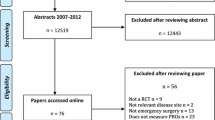Abstract
Introduction
Surgical trials focus mainly on mortality and morbidity rates, which may be not the most important endpoints from the patient's perspective. Evaluation of expectations and needs of patients enrolled in clinical trials can be analyzed using a procedure called ranking. Within the Postsurgical Pain Outcome of Vertical and Transverse Abdominal Incision randomized trial (POVATI), the perspectives of participating patients and surgeons were assessed as well as the influence of the surgical intervention on patients' needs.
Patients and methods
All included patients of the POVATI trial were asked preoperatively and postoperatively to rank predetermined outcome variables concerning the upcoming surgical procedure (e.g., pain, complication, cosmetic result) hierarchically according to their importance. Preoperatively, the surgeons were asked to do the same.
Results
One hundred eighty two out of 200 randomized patients (71 females, 111 males; mean age 59 years) returned the ranking questionnaire preoperatively and 152 patients (67 females, 85 males; mean age 60 years) on the day of discharge. There were no differences between the two groups with respect to the distribution of ranking variables (p > 0.05). Thirty-five surgeons (7 residents, 6 fellows, and 22 consultants) completed the same ranking questionnaire. The order of the four most important ranking variables for both patients and surgeons were death, avoiding of postoperative complications, avoiding of intraoperative complications, and pain. Surgeons ranked the variable “cosmetic result” significantly as more important compared to patients (p = 0.034, Fisher's exact test).
Conclusion
Patients and surgeons did not differ in ranking predetermined outcomes in the POVATI trial. Only the variable “cosmetic result” is significantly more important from the surgeon's than from the patient's perspective. Ranking of outcomes might be a beneficial tool and can be a proper addition to RCTs.



Similar content being viewed by others
Abbreviations
- POVATI:
-
Postsurgical Pain Outcome of Vertical and Transverse Abdominal Incision
References
Goodman SN (2005) Ethics and evidence in clinical trials. Clin Trials 2(3):195–6
Howland RH (2007) Limitations of evidence in the practice of evidence-based medicine. J Psychosoc Nurs Ment Health Serv 45(11):13–6
Woolf SH, George JN (2000) Evidence-based medicine. Interpreting studies and setting policy. Hematol Oncol Clin North Am 14(4):761–84
King M, Nazareth I, Lampe F, Bower P, Chandler M, Morou M et al (2005) Conceptual framework and systematic review of the effects of participants' and professionals' preferences in randomised controlled trials. Health Technol Assess 9(35):1–186, iii–iv
Nies C, Celik I, Lorenz W, Koller M, Plaul U, Krack W et al (2001) Outcome of minimally invasive surgery. Qualitative analysis and evaluation of the clinical relevance of study variables by the patient and physician. Chirurg 72(1):19–28, discussion 28–19
Knaebel HP, Diener MK, Wente MN, Bauer H, Buchler MW, Rothmund M et al (2005) The Study Centre of the German Surgical Society—rationale and current status. Langenbecks Arch Surg 390(2):171–7
Garlipp B, Ptok H, Schmidt U, Meyer F, Gastinger I, Lippert H (2010) Neoadjuvant chemoradiotherapy for rectal carcinoma: effects on anastomotic leak rate and postoperative bladder dysfunction after non-emergency sphincter-preserving anterior rectal resection. Results of the Quality Assurance in Rectal Cancer Surgery multicenter observational trial. Langenbecks Arch Surg 395(8):1031–8
Masaki T, Matsuoka H, Kobayashi T, Abe N, Takayama M, Tonari A et al (2010) Quality assurance of pelvic autonomic nerve-preserving surgery for advanced lower rectal cancer—preliminary results of a randomized controlled trial. Langenbecks Arch Surg 395(6):607–13
Nomura K, Ohno M, Fujinuma Y, Ishikawa H (2007) Patient autonomy preferences among hypertensive outpatients in a primary care setting in Japan. Intern Med 46(17):1403–8
Shah MB, Bentley JP, McCaffrey DJ 3rd (2006) Evaluations of care by adults following a denial of an advertisement-related prescription drug request: the role of expectations, symptom severity, and physician communication style. Soc Sci Med 62(4):888–99
King M, Nazareth I, Lampe F, Bower P, Chandler M, Morou M et al (2005) Impact of participant and physician intervention preferences on randomized trials: a systematic review. JAMA 293(9):1089–99
Rockwood TH, Church JM, Fleshman JW, Kane RL, Mavrantonis C, Thorson AG et al (1999) Patient and surgeon ranking of the severity of symptoms associated with fecal incontinence: the fecal incontinence severity index. Dis Colon Rectum 42(12):1525–32
Dindo D, Demartines N, Clavien PA (2004) Classification of surgical complications: a new proposal with evaluation in a cohort of 6336 patients and results of a survey. Ann Surg 240(2):205–13
Rief W, Stock C, Geissner E, Fichter MM (1994) When patient and therapist disagree—discrepancies in evaluation of change. Psychother Psychosom Med Psychol 44(7):235–9
Brown SR, Goodfellow PB (2005) Transverse verses midline incisions for abdominal surgery. Cochrane Database Syst Rev (4):CD005199
Reidel MA, Knaebel HP, Seiler CM, Knauer C, Motsch J, Victor N et al (2003) Postsurgical pain outcome of vertical and transverse abdominal incision: design of a randomized controlled equivalence trial [ISRCTN60734227]. BMC Surg 3:9
Seiler CM, Deckert A, Diener MK, Knaebel HP, Weigand MA, Victor N et al (2009) Midline versus transverse incision in major abdominal surgery: a randomized, double-blind equivalence trial (POVATI: ISRCTN60734227). Ann Surg 249(6):913–20
Clavien PA, Barkun J, de Oliveira ML, Vauthey JN, Dindo D, Schulick RD et al (2009) The Clavien–Dindo classification of surgical complications: five-year experience. Ann Surg 250(2):187–96
Hunt CM, Camargo CA Jr, Dominitz JA, Bute BP, Clavien PM (1998) Effect of postoperative complications on health and employment following liver transplantation. Clin Transplant 12(2):99–103
Conflicts of interest
None.
Author information
Authors and Affiliations
Corresponding author
Rights and permissions
About this article
Cite this article
Fischer, L., Deckert, A., Diener, M.K. et al. Ranking of patient and surgeons' perspectives for endpoints in randomized controlled trials—lessons learned from the POVATI trial [ISRCTN 60734227]. Langenbecks Arch Surg 396, 1061–1066 (2011). https://doi.org/10.1007/s00423-011-0798-3
Received:
Accepted:
Published:
Issue Date:
DOI: https://doi.org/10.1007/s00423-011-0798-3




